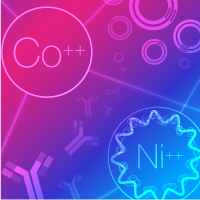Many biomedically relevant proteins require something beyond standard expression in E. coli. Mammalian expression systems offer the advantages of proper folding and post-translational modifications not possible in prokaryotic cells. Recombinant antibodies are increasingly important subjects for research, and mammalian expression systems are popular platforms for these studies. Being able to rely on vectors that produce high expression of functional antibodies is a critical piece of the puzzle.
Tech Note
High expression of functional OKT3 monoclonal antibodies in mammalian cells
pHEK293 Ultra Expression Vectors
Introduction
Results
TAR-Tat transactivation for ultra-high protein expression in mammalian cells
The pHEK293 Ultra Expression Vector systems exploit the HIV-1 TAR-Tat transcriptional activation mechanism to express proteins of interest at ultra-high levels in human HEK 293 cells. These systems are capable of providing protein expression up to 10 times higher than what is typically obtained with vectors containing CMV-derived promoters. Please visit our overview page to learn more about this transcriptional activation mechanism.
The pHEK293 Ultra Expression system is available in two formats. The single-vector format (Cat. # 3390) allows for high expression of your protein of interest with the convenience of single-plasmid transfection. The double-vector system (Cat. # 3392) includes a separate Enhancer Vector. While experiments with this system will require cotransfection of cells with both plasmids, they will give you the ability to optimize expression levels by varying the ratio of the two vectors.
Quantification of highly expressed monoclonal antibodies
The double-vector system (pHEK293 Ultra Expression Vector II, Cat. # 3392) was used to produce anti-human CD3 IgG monoclonal antibody clone OKT3. The pHEK293 Ultra Expression Vector II system was compared to a negative control and a vector with a CMV-derived promoter (pBApo-CMV DNA). Protein expression was examined in adherent and suspension cells transfected as shown in the table below. Cells were cotransfected with IgG heavy chain (HC) and light chain (LC) expression constructs. Culture samples taken at 2, 5, 7, and 9 days after transfection showed high expression for all of the pHEK293 vector conditions; expression levels were 5- to 7-fold higher than with the CMV vector.
| Experimental setup | |||||||
|---|---|---|---|---|---|---|---|
| Experimental condition | Cell type | IgG heavy chain (HC) expression vector | IgG light chain (LC) expression vector | pHEK293 Enhancer Vector amount (µg) | |||
| Vector | Amount (µg) | Vector | Amount (µg) | ||||
| 1 | Adherent HEK 293T cells | pBApo-CMV1/HC | 0.5 | pBApo-CMV/LC | 0.5 | n/a | |
| 2 | Vector II2/HC | 0.5 | Vector II/LC | 0.5 | 0.008 | ||
| 3 | Vector II/HC | 0.5 | Vector II/LC | 0.5 | 0.2 | ||
| 4 | Negative Control | n/a | Negative Control | n/a | |||
| 5 | Suspension HEK 293 cells | pBApo-CMV/HC | 15 | pBApo-CMV/LC | 15 | n/a | |
| 6 | Vector II/HC | 15 | Vector II/LC | 15 | 0.24 | ||
| 7 | Vector II/HC | 15 | Vector II/LC | 15 | 6 | ||
| 8 | Negative Control | n/a | Negative Control | n/a | n/a | ||
- pBApo-CMV DNA vector
- pHEK293 Ultra Expression Vector

Quantitative results of OKT3 production. Cell culture supernatants were collected at 2, 5, 7, and 9 days post-transfection. Quantification was performed using the Mouse IgG EIA Kit (Cat. # MK137). Transfections done with the pHEK293 vector systems show a clear increase in protein expression over the pBApo-CMV DNA vector.The suspension cells expressing the OKT3 antibody from the pBApo-CMV vector (condition 5) and pHEK293 Ultra Expression Vector II (condition 7) were harvested at the end of the protocol above. When OKT3 was recovered and quantified from these cultures, the pHEK293 vector system yielded an impressive 269.6 µg of purified antibody from 27 ml of culture, while the same volume of culture transfected with the CMV vector yielded only 55 µg.
Native SDS-PAGE was performed with these two purified samples under reducing and non-reducing conditions. Results show that OKT3 expressed with the pHEK293 Ultra Expression Vector II system produced the expected band pattern (Lanes 2 in gels shown below), suggesting that this highly expressed, purified antibody has the correct structure.

Native SDS-PAGE of purified OKT3 antibody. A positive control (hybridomas expressing OKT3, 6 days of culture) was treated in parallel with the purification of the two experimental samples. Native SDS-Page was run under reducing and non-reducing conditions, using SDS buffer with and without a reducing agent (DTT), respectively.
Functional evaluation of the expressed antibody in mammalian cell culture
While ultra-high expression and correct structure are good indicators, characterizing antibody function is critical. As a first assessment, flow cytometry was used to look at the binding activity of purified OKT3 from the above experimental samples and a positive control sample obtained from hybridomas. With the positive control set at 100%, the pBApo-CMV DNA vector sample had 109.3% activity and the pHEK293 Ultra Expression Vector II sample had 119% activity. Thus, the binding activity of the overexpressed antibody from the pHEK293 Vector II system was comparable to the positive control.
The OKT3 monoclonal antibody binds to antigen receptors on the surface of human T lymphocytes, resulting in activation and expansion of T cells. The purified OKT3 samples were evaluated for these lymphocyte proliferation effects in vitro. Addition of the various OKT3 samples promoted clustering and activation of lymphocytes in all instances as observed by microscopy (Panel A, below). OKT3 produced by the pHEK293 Ultra Expression Vector II system resulted in expansion comparable to that of the hybridoma control, as well as that of the other vector (Panel B, below).

Lymphocyte proliferation results. OKT3 samples were added on Day 0. Dilutions were made on Days 4 and 7. Lymphocytes were harvested on Day 10. Panel A. Cell culture photos taken on Day 4 following addition of OKT3 samples purified from cells transfected with the pBApo-CMV DNA vector, the pHEK 293 Ultra Expression Vector II, the hybridoma positive control, and a negative control (no OKT3). Panel B. Quantification of the fold expansion of the lymphocytes over the course of 10 days.
On Day 10, the cells were harvested to analyze the levels of the surface antigens CD3, CD4, and CD8 by flow cytometry. Lymphocyte activation by OKT3 obtained from the pHEK293 Ultra Expression Vector II system displayed surface antigen patterns comparable to those of other OKT3 sources. These results indicate that OKT3 produced by this system has the same lymphocyte stimulatory capacity and high productivity as antibodies produced by other systems.

Flow cytometry analysis of surface antigens CD3, CD4, and CD8. Flow cytometry data is shown for the OKT3 samples from the two vector systems, the positive hybridoma control, and the negative control (no OKT3).
Conclusions
pHEK293 Ultra Expression Vectors provide ultra-high expression of recombinant proteins, including antibodies, in mammalian cells. While the single-vector system has the advantage of convenience, the double-vector system grants the opportunity to optimize expression levels of the protein of interest. With antibody expression levels shown to be 5–7 times higher than those obtained from vectors with traditional CMV-derived promoters, it is possible to produce large quantities of antibodies using HEK 293 cells. In addition, the production of functional protein underscores this system's usefulness when proper folding and/or post-translational modifications are necessary.
Methods
For expression and functional assessment of anti-CD3 IgG (clone OKT3) heavy and light chains, adherent HEK 293T/17 cells were cultured in a 12-well cell culture plate; HEK 293 suspension cells (FreeStyle 293-F Cells; Thermo Fisher Scientific) were cultured in 125-ml Erlenmeyer flasks. Both types of cells were cotransfected with IgG heavy chain (HC) and light chain (LC) expression vectors. All transfections were performed according to the recommended protocol.
Adherent and suspension cell culture supernatant samples were collected 2, 5, 7, and 9 days after transfection. Quantification was performed using the Mouse IgG EIA Kit (Cat. # MK137), as per the instructions in the user manual. After Day 9, suspension cell cultures were centrifuged (15,000 rpm for 10 min), and OKT3 antibodies from each supernatant were recovered using Protein A column purification, followed by desalting by ultrafiltration. Purified OKT3 IgG was quantified using the Mouse IgG EIA Kit, as above. A positive control (hybridomas expressing OKT3, 6 days of culture) was also treated in the same manner. The positive control yielded 117 µg of purified OKT3 from 7 ml of culture supernatant. These purified OKT3 samples were used in flow cytometry and SDS-PAGE analyses. Native SDS-PAGE was performed under reducing and non-reducing conditions using SDS buffer with and without a reducing agent, respectively. 1.2 µl of each sample was loaded in each lane. For the lymphocyte proliferation culture test, peripheral blood mononuclear cells (PBMC) obtained (with informed consent) from healthy human donors were adjusted to 1.0 x 106 cells/ml in culture medium. Various OKT3 samples were added at 30 ng/ml, and cells were cultured with 5% CO2 at 37°C. On Days 4 and 7, cells were diluted in medium without OKT3 in order to achieve 2.0 x 106cells/ml, and cultured further. On Day 10, the cells were harvested to analyze CD3, CD4, and CD8 by flow cytometry.
Visit the product page for pHEK293 Ultra Expression Vectors »
Related products
Takara Bio USA, Inc.
United States/Canada: +1.800.662.2566 • Asia Pacific: +1.650.919.7300 • Europe: +33.(0)1.3904.6880 • Japan: +81.(0)77.565.6999
FOR RESEARCH USE ONLY. NOT FOR USE IN DIAGNOSTIC PROCEDURES. © 2025 Takara Bio Inc. All Rights Reserved. All trademarks are the property of Takara Bio Inc. or its affiliate(s) in the U.S. and/or other countries or their respective owners. Certain trademarks may not be registered in all jurisdictions. Additional product, intellectual property, and restricted use information is available at takarabio.com.





